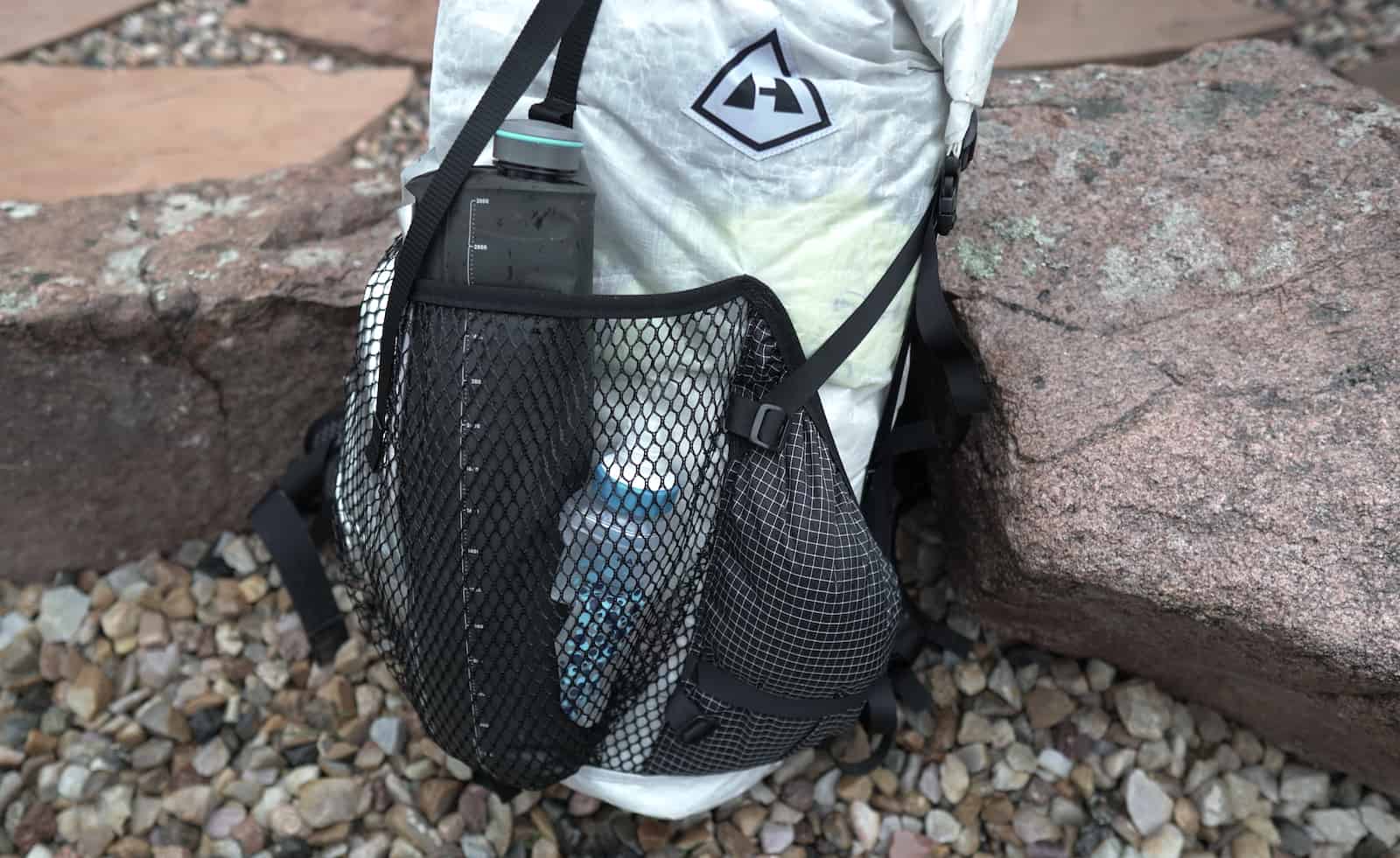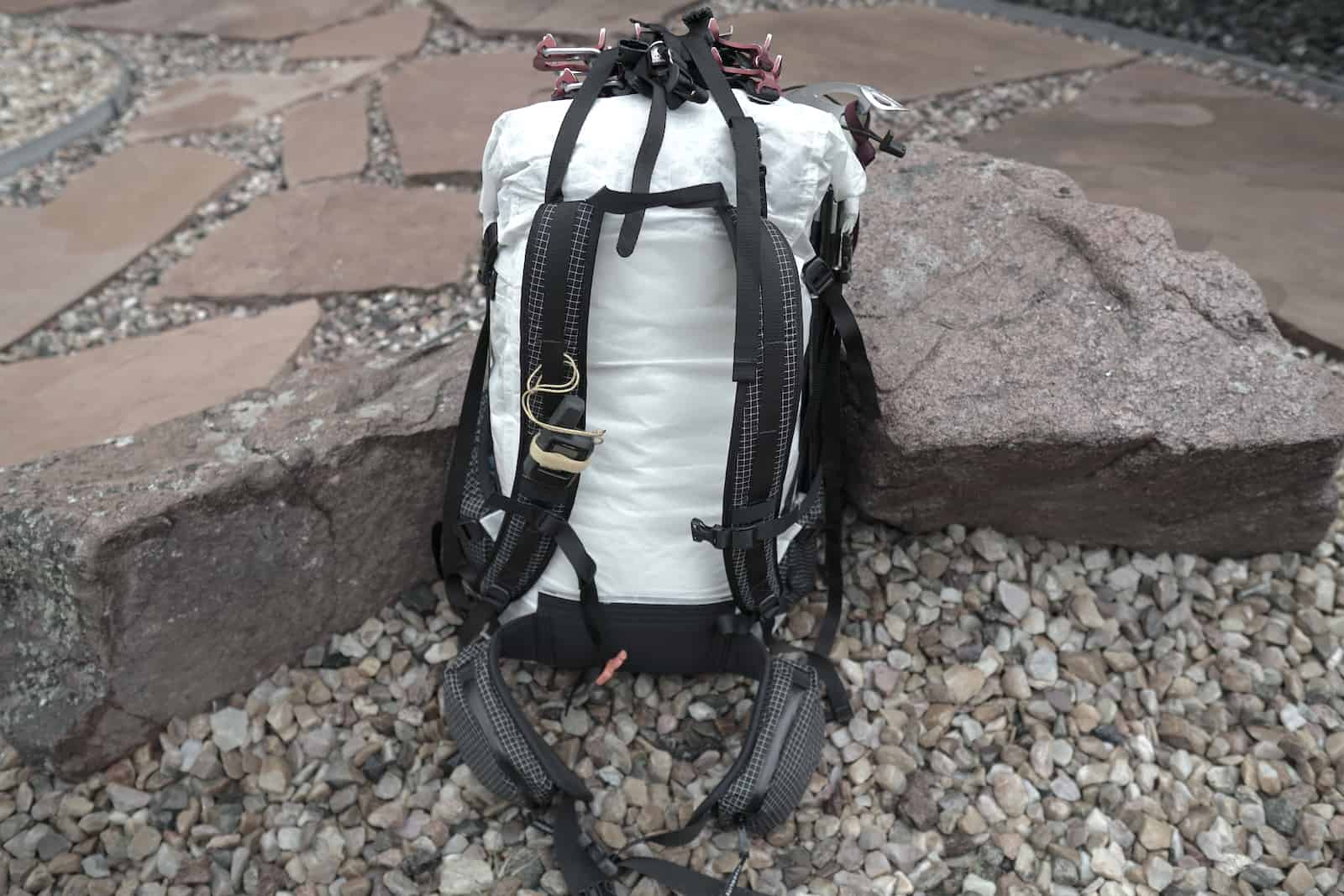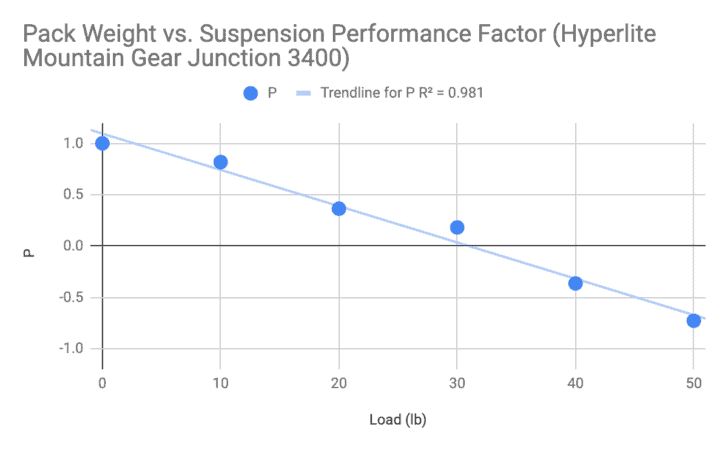Introduction
The Hyperlite Mountain Gear Junction backpack offers a similar physical configuration (one large rear pocket, two side pockets, two hip belt pockets, roll-top closure) as their Windrider, Southwest, and Northrim packs, but in a slightly different fabric configuration.
In short, the Junction offers a lightweight fabric main pack body, woven fabric side and hip belt pockets for durability, and a mesh back pocket for storing wet gear. A comparison of the material specs for all four packs can be found in the “Compared To…” section below.

The Junction is available in two sizes (2400 and 3400 cubic inch main pack bag volume). In this review, I’m using a Junction 3400 in size Large.
I believe that the Junction 3400 is the most versatile pack in HMG’s product line, and should be considered by anyone looking for a do-it-all pack that is highly water-resistant, durable, comfortable (with loads of less than 30 pounds), and has the perfect pocket configuration that can be adapted to most hiker’s trekking styles and preferences.
Watch my Video Review below (or via YouTube):

Features
- One external rear mesh pocket
- Two solid-panel side pockets
- Two zippered pockets on hip belt with #5 YKK zipper
- Hip belt with 1/8 inch closed cell rigid foam, 1/4 inch closed cell foam, and spacer mesh
- Shoulder straps with 3/8 inch closed cell foam and spacer mesh
- Adjustable sternum strap with self-tensioning elastic and whistle
- Hydro port and internal mesh hydro sleeve
- Removable, contoured aluminum stays
- 1/4 inch foam back panel pad
- Compression System
- roll-top closure system with side compression straps for vertical compression
- side compression straps for horizontal compression
- top Y-strap compression can be used to secure gear
- Seam sealing on all side seams and behind all sewn-on pack features
- Bar-tacked reinforcements on all stress points
- Four exterior tri-glide buckles for optional pack accessory straps
- Ice axe loop
- Made in USA (Maine)
Specifications
Materials:
- Body: DCH50
- Bottom: DCH150
- Side External Pockets: Hardline
- Rear External Pocket: Polyester Mesh
- Hip Belt Pockets: Hardline
See “Compared To…” section below for additional discussion and specifications about each of these materials and how they compare to the materials used in the Hyperlite Mountain Gear Windrider, Northrim, and Southwest backpacks.
Dimensions:
| Junction 2400 | Junction 3400 | |
|---|---|---|
| Weight | 30.1 oz (853 g) | 32.0 oz (907 g) |
| Load Capacity | 40 lb (18 kg) | 40 lb (18 kg) |
| Internal Volume | 2400 cu. in. (40 L) | 3400 cu. in. (55 L) |
| Center Pocket Volume | 300 cu. in. (4.9 L) | 300 cu. in. (4.9 L) |
| Side Pocket Volume | 2 x 150 cu. in. (4.9 L) | 2 x 150 cu. in. (4.9 L) |
| Hip Belt Pocket Volume | 2 x 55 cu. in. (0.9 L) | 2 x 55 cu. in. (0.9 L) |
| Total Pack Volume | 3110 cu. in. (51 L) | 4110 cu. in. (66 L) |
| Top Circumference | 37.5 in (95.3 cm) | 40.0 in (101.6 cm) |
| Bottom Circumference | 33.5 in (85.1 cm) | 33.5 in (85.1 cm) |
| Height (Fully Unrolled) | 30.0 in (72.6 cm) | 34.0 in (86.4 cm) |
| Back Width | 10.5 in (26.7 cm) | 10.5 in (26.7 cm) |
All specs above were provided by the manufacturer. Note that these dimensions are similar to the Hyperlite Mountain Gear Windrider 2400/3400, Southwest 2400/3400, and Northrim 3400.
Actual Measured Weight
The actual measured weight of our production model pack (3400, torso size L) is 32.8 oz (930 g).
Commentary
I’ve been using (and abusing) Hyperlite Mountain Gear backpacks since the company launched in 2010. I’ve used HMG packs for alpine and ice climbing, backpacking, packrafting, backcountry skiing, and day-tripping. I’ve worn out HMG pack fabrics as a result of alpine scrambling, busted hip belt seams when I loaded them with up to obscene amounts of weight on long expeditions, and shredded mesh pockets while bushwhacking. This is the context for the commentary I present in this section.
Pocket Materials and Usability
The most unique feature of the Hyperlite Mountain Gear Junction backpack, when compared to the Windrider, Southwest, or Northrim, is the material configuration of the external pockets.
Hyperlite Mountain Gear uses three different materials in the external pockets of their various packs (refer to the table in the “Compared To…” section below for exact specs):
- Mesh – best for visibility and stowing wet gear
- Hardline – best for content privacy, durable storage of sharp items, and bushwhacking
- DCHW – best for extreme durability and abrasion resistance
I find mesh pockets to be most useful for stowing wet gear (ground cloth, tarp or tent fly, raingear), and Hardline pockets most useful for stowing sharp items (tent poles, camera tripod) that have a history of poking holes in my mesh pockets.
My YouTube video review includes a bit about how I organize my gear in the Hyperlite Mountain Gear Junction backpack.
I prefer the DCHW (fully-woven Dyneema + DCF) pockets of the Northrim for rock scrambling (desert canyons, alpine climbing), but appreciate the Hardline+mesh pocket configuration on the Junction for backpacking and most off-trail trekking and bushwhacking.
Having shredded the side mesh pockets on a Hyperlite Mountain Gear Windrider while bushwhacking through slide alder, willow, birch, and burn areas, I’m not enthused about mesh side pockets. The Hardline side pockets on the Junction are a welcome addition.
Likewise, I also found the Southwest pack (which uses Hardline for all of its external pockets) to be lacking, because I wanted the ability to stow wet gear in a mesh pocket. That the mesh pocket is located on the rear of the Junction, protected from snagging while bushwhacking, is important to note.
Thus, I think the pocket configuration of the Junction (Hardline side pockets, rear mesh pocket) provides the best configuration that is versatile enough to meet the needs of most hikers.
Water Resistance
The DCH50 and DCH150 fabrics used in the body of HMG’s packs, including the junction, are waterproof and absorb less water than virtually any other pack fabric I’ve used. Bonded seams and the roll-top design of HMG packs make them virtually waterproof. Even while packrafting, I seldom worry about the gear inside my pack, and simply stow it inside seam-taped stuff sacks (no dry bags).
Packbag Durability
The DCH50 used in the body of the junction, and the DCH150 used on the bottom of the Junction, are plenty durable for virtually any type of on-trail or light off-trail trekking.
My DCH50 backpacks have only suffered from durability issues when I take them on alpine scrambles around sharp limestone (e.g., the Bob Marshall Wilderness) or in sandstone slot canyons (e.g., the US Desert Southwest). In that environment, I’ve even blown holes in the DCH150 bottoms of my HMG packs. That’s an environment where I’d want a full-spectra bottom and external pockets, like what is available in the Hyperlite Mountain Gear Northrim pack.
Load-Carrying Comfort
All of Hyperlite Mountain Gear’s 2400-series and 3400-series packs have a manufacturer-claimed load carrying capacity of 40 pounds (the larger 4400-series and 5400-series packs offer load carrying capacities of up to 65 pounds). It’s important to note before we dive into this discussion any further that this is a recommended load limit and not a load that’s necessarily going to be comfortable.

I’ve used the Hyperlite Mountain Gear Porter 4400 and 5400 more than any other HMG pack – often with loads exceeding 50 pounds. This is the amount of weight I will typically carry on longer (10+ days) trips without resupply, and often with packrafting and/or alpine climbing gear.
However, I have seldom packed their smaller (2400, 3400) packs with more than the manufacturer-stated load carrying capacity of 40 pounds. And so, I was curious about how these smaller packs fared when pack weights went up. For example, with a 15-pound base weight (common for me during the summer when I’m carrying camera equipment), 10 days of food (16 pounds), and the 4L of water (8 lb) I usually carry when I’m dry-camping above the treeline – I’m pushing the 40-pound mark.
In order to study this, I performed suspension collapse tests based on a protocol I developed for analyzing suspension performance and determining the load-carrying capacity of a backpack. This protocol has been demonstrated on frameless packs, and I still use it regularly to measure the ability of a pack suspension to resist collapse under load.
For evaluating suspension performance at a specific load, my wife took two measurements: one from the ground surface to the midline of the hipbelt, and one from the ground surface to the top of the frame. The difference between these two measurements is the effective torso length of the pack under load. The effective torso length of a pack under load has a high degree of correlation with perceived comfort. Thus, using the quantitative analysis from the suspension performance protocol, a pack’s comfortable load-carrying capacity can be derived by determining the load at which the suspension performance factor (P) = 0.
The following chart illustrates the suspension performance of the Hyperlite Mountain Gear Junction 3400:

From this chart, a comfortable load-carrying capacity can be estimated at around 31 pounds. This is certainly in line with my experience with the Junction. At weights significantly greater than 30 pounds, the Junction’s minimalist frame starts to collapse significantly, becoming shorter than my body’s torso length. This prevents effective weight transfer between the shoulders and hips.
At 40 pounds, the shoulder straps start to pull downward and backward, straining shoulder muscles. By the time the pack is loaded with 50 pounds, be prepared for significant collapsing of the hip belt structure.
Given the Junction’s minimalist hip belt padding (1/8″ closed-cell rigid foam + 1/4 closed cell foam + spacer mesh) and shoulder strap padding (3/8″ + spacer mesh), once the frame of the pack starts to collapse at weights above 30 pounds, don’t expect it to maintain a high level of comfort.
If you have a shorter torso and expect to regularly carry weights greater than 30 pounds, consider sizing up one size. The longer frame length of a larger torso pack will then give you some wiggle room at heavy loads.
Torso Sizing and Comfortable Load Carrying Capacity
Here is Hyperlite Mountain Gear’s pack sizing guide:
- Small (15.0” – 17.0” torso)
- Medium (17.0” – 19.0” torso)
- Large (19.0” – 21.0” torso)
- Tall (21.0”+ torso)
Noting that your torso measurement is the vertical distance between your iliac crest and your 7th cervical (C7) vertebra.
When unweighted, our size Large Junction had a measured pack torso length (defined as the vertical distance between the crest of the shoulder straps and the midline of the hip belt) of 19 1/8 inches. My torso as measured from C7 to about one inch below the iliac crest (the point where I want the midline of my hip belt to ride) is about 17 3/4 inches. Thus, someone with a torso that measures in the “large” range as defined by Hyperlite Mountain Gear may find that their pack has a lower comfortable load-carrying capacity than identified in this review.
Strengths
- Solid fabric side pockets, combined with mesh rear pocket, provide the ideal blend of durability (side pockets) and wet gear storage (rear pocket) that gives this pack versatility over a wide range of trail and off-trail conditions.
- Packbag is nearly waterproof and absorbs very little water.
- High-quality construction, durable materials, and attention to detail.
- Some attachment options (two plastic loops on each rear panel-side panel seam, daisy connection at bottom of roll-top strap on rear panel) can be used to rig trekking poles, ice axe, etc. (additional straps not included).

Weaknesses
- Minimalist suspension and thinly-padded harness may not be comfortable for some users at loads exceeding 30 pounds unless you have well-conditioned trapezius muscles and some internal hip padding built into your body.
- Torso sizing seems on the short side – consider sizing up one size.
- Hip belt pockets are integrated with the belt (instead of free-floating), so rigid items in the pockets or overstuffed pockets can interfere with hip belt shape.
- Ice axe loop is located below the center of the rear mesh pocket, so when the pocket is full, the loop cannot be used.
- Side pockets are pretty deep (a storage advantage) but contents may be difficult to access if you have shorter arms.

Compared To
The table below compares all six of Hyperlite Mountain Gear’s fabric configurations (3400 cubic inch main body size was selected to compare weights consistently).
| Junction 3400 | Northrim 3400 | Windrider 3400 (White) | Windrider 3400 (Black) | Southwest 3400 (White) | Southwest 3400 (Black) | |
|---|---|---|---|---|---|---|
| Weight (oz) | 32 | 35.1 | 31.9 | 34.8 | 32.1 | 35 |
| Load Capacity (lb) | 40 | 40 | 40 | 40 | 40 | 40 |
| Body Material | DCH50 | DCH150 | DCH50 | DCH150 | DCH50 | DCH150 |
| Bottom Material | DCH150 | DCHW | DCH150 | DCH150 | DCH150 | DCH150 |
| External Side Pocket Material | Hardline | DCHW | Mesh | Mesh | Hardline | Hardline |
| External Back Pocket Material | Mesh | DCHW | Mesh | Mesh | Hardline | Hardline |
| Hip Belt Pocket Material | Hardline | DCHW | Hardline | Hardline | Hardline | Hardline |
| MSRP | $345 | $410 | $345 | $365 | $345 | $365 |
Material Descriptions:
- DCH50 – 50 denier polyester face fabric laminated to a Dyneema Composite Fabric backing (3.5 oz/sq. yd.)
- DCH150 – 150 denier polyester face fabric laminated to a Dyneema Composite Fabric backing (5.0 oz/sq. yd.)
- DCHW – 375 denier 100% woven Dyneema laminated to a Dyneema Composite Fabric backing (5.0 oz/sq. yd.)
- Hardline – 210 denier woven nylon with 10×10 mm 200 denier Dyneema ripstop (4.9 oz/sq. yd.), water-resistant coating (900 mm)
- Mesh – 100% polyester open mesh (4.4 oz/sq. yd.)
Which Hyperlite Mountain Gear Pack is Best for Me?
Based on the specs in the table above, here are the most obvious use-case scenarios for each pack:
- Windrider – provides the best visibility into pocket contents, best water drainage from pockets
- Southwest – more durability than the Windrider, best for bushwhacking
- Northrim – most durable, best for rock scrambling
- Junction – durability on side pockets for bushwhacking, mesh on rear for stowing wet gear
Final Conclusion
The Hyperlite Mountain Gear Junction 3400 is probably the most versatile backpack in HMG’s product line for most users.
If you only want to own one HMG pack, and you spend most of your time on trail or off-trail in open or bushy terrain, the Junction may be your best option.
If you need more durability for long expeditions in desert canyons or alpine limestone, check out the Northrim.
If you plan to regularly carry loads in excess of 30 pounds, consider sizing up one torso size. If you plan to regularly carry loads in excess of 40 pounds, consider a 4400-series pack.
I don’t recommend the Junction if your average pack weight (your pack weight at the mid-point of a trip) exceeds 35 pounds. This shouldn’t be much of a problem for trips up to a week in length if your base weight is less than 20 pounds and you’re not carrying more than a liter or two of water at a time.
Where to Buy
- Learn more about the Junction Backpack at Hyperlite Mountain Gear.
- Hyperlite Mountain Gear packs and accessories are also available from REI.
Related Content
- Hyperlite Mountain Gear Porter 5400 Review
- Hyperlite Mountain Gear Porter 4400 Review
- Hyperlite Mountain Gear Windrider Review
- Podcast: Dyneema Composite Fabrics
Product Review Disclosure
Updated September 15, 2018
- How we acquired these products: Product(s) discussed in this review were either acquired by the author from a retailer or otherwise provided by the manufacturer at a discount/donation with no obligation to provide media coverage or a product review to the manufacturer(s).
- We do not accept money or in-kind compensation for guaranteed media coverage: Backpacking Light does not accept compensation or donated product in exchange for guaranteed media placement or product review coverage.
- Affiliate links: Some (but not all) of the links in this review may be “affiliate” links, which means if you click on a link to one of our affiliate partners (usually a retailer site), and subsequently make a purchase with that retailer, we receive a small commission. This helps us fund our editorial projects, podcasts, instructional webinars, and more, and we appreciate it a lot! Thank you for supporting Backpacking Light!



Home › Forums › Hyperlite Mountain Gear Junction Backpack Review